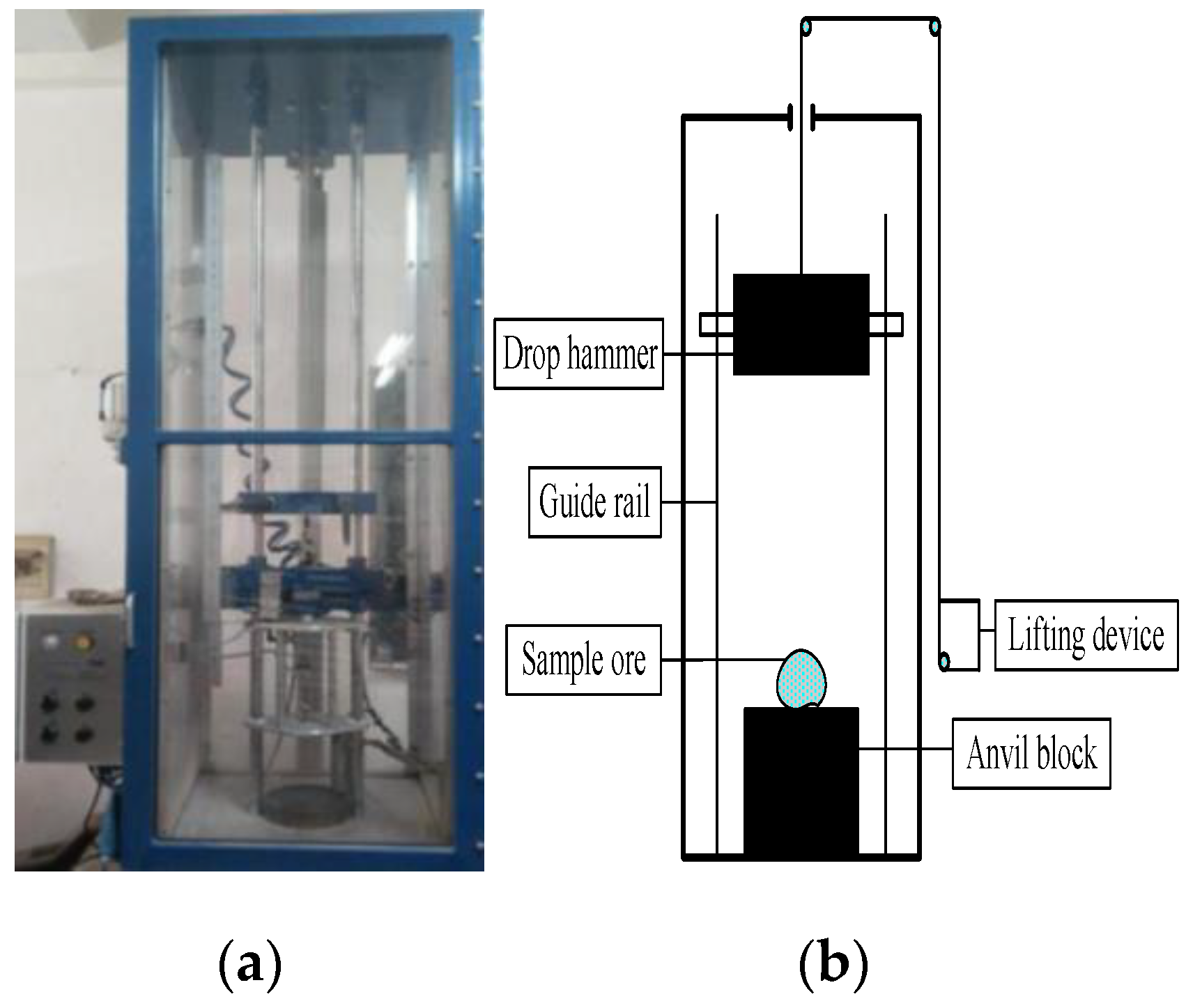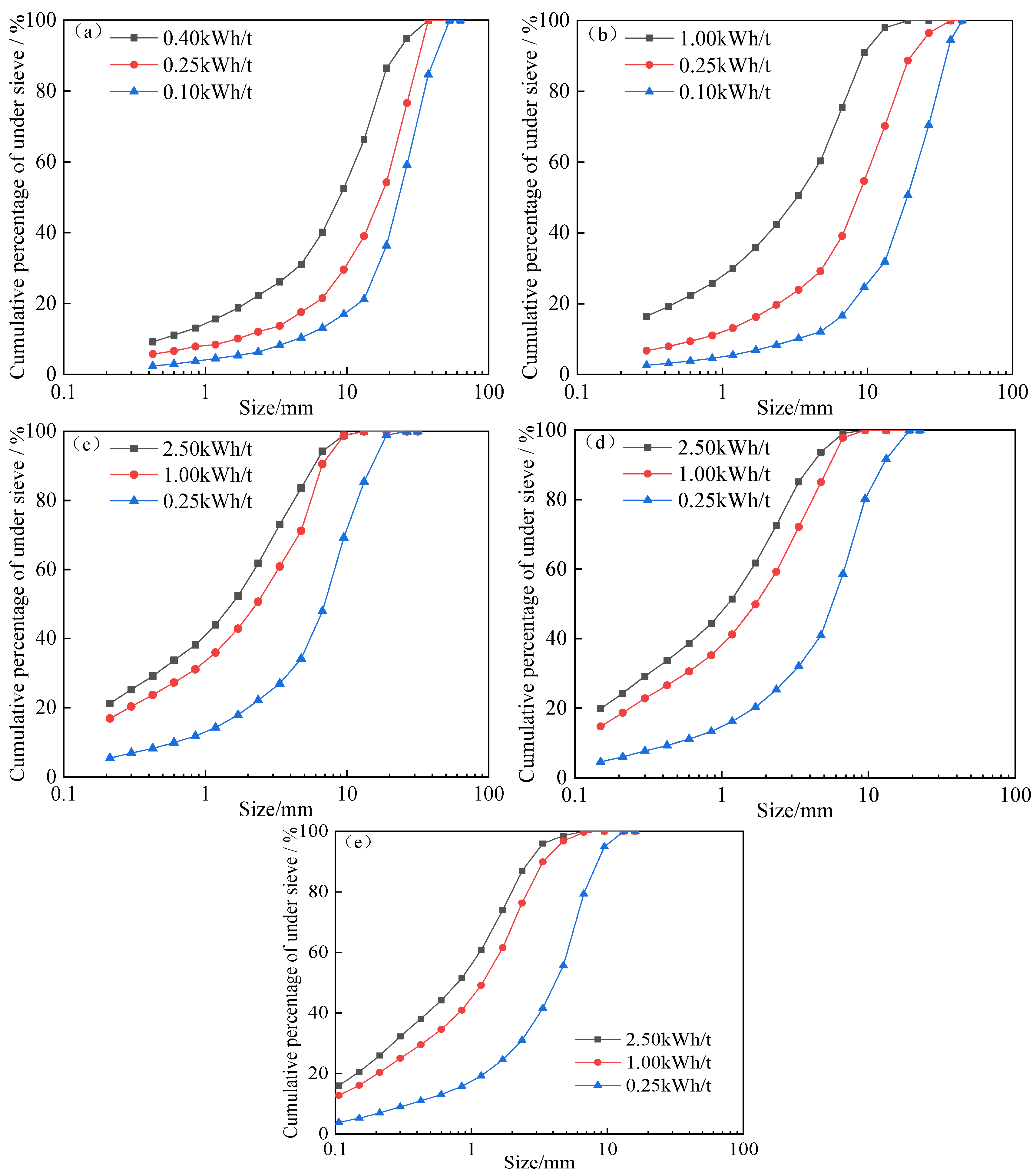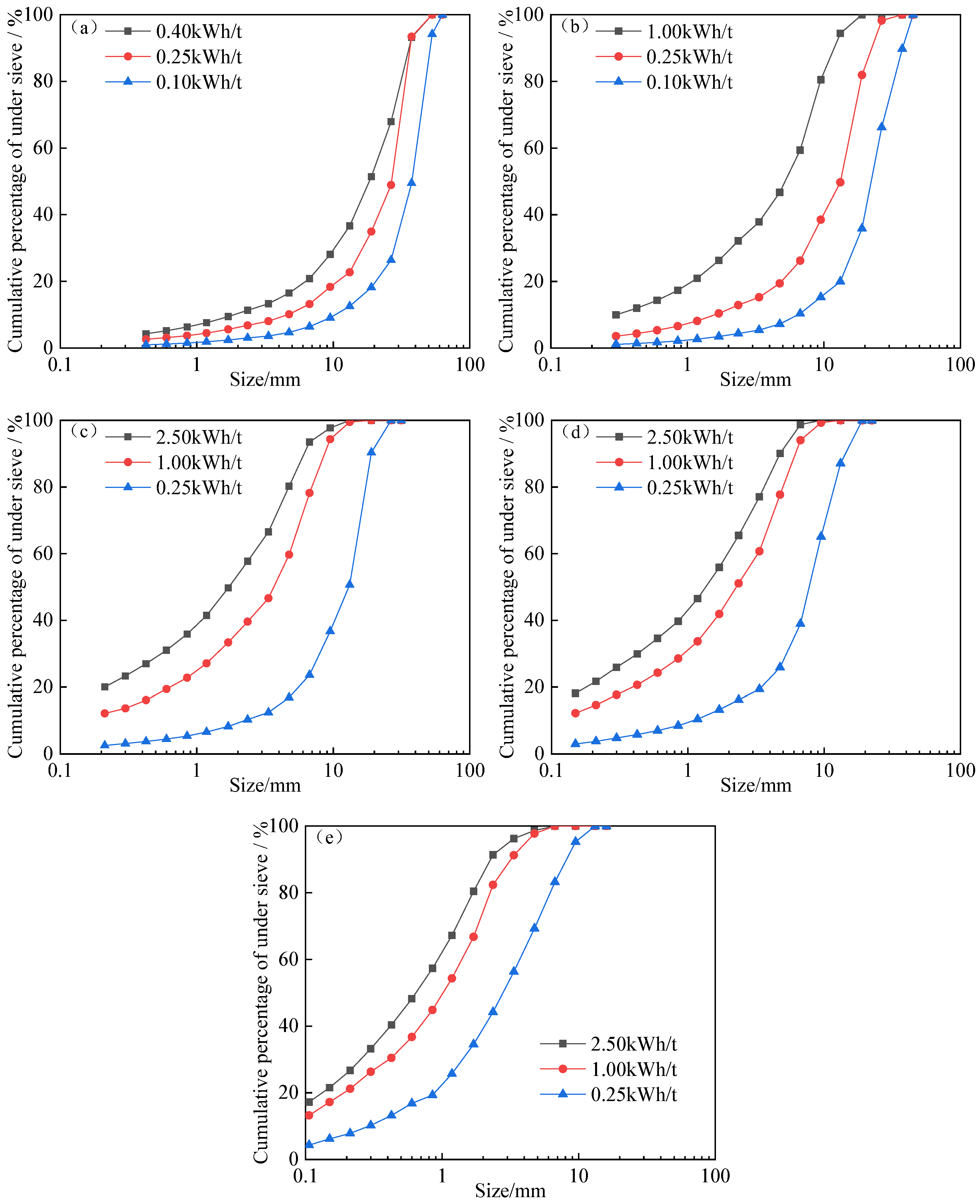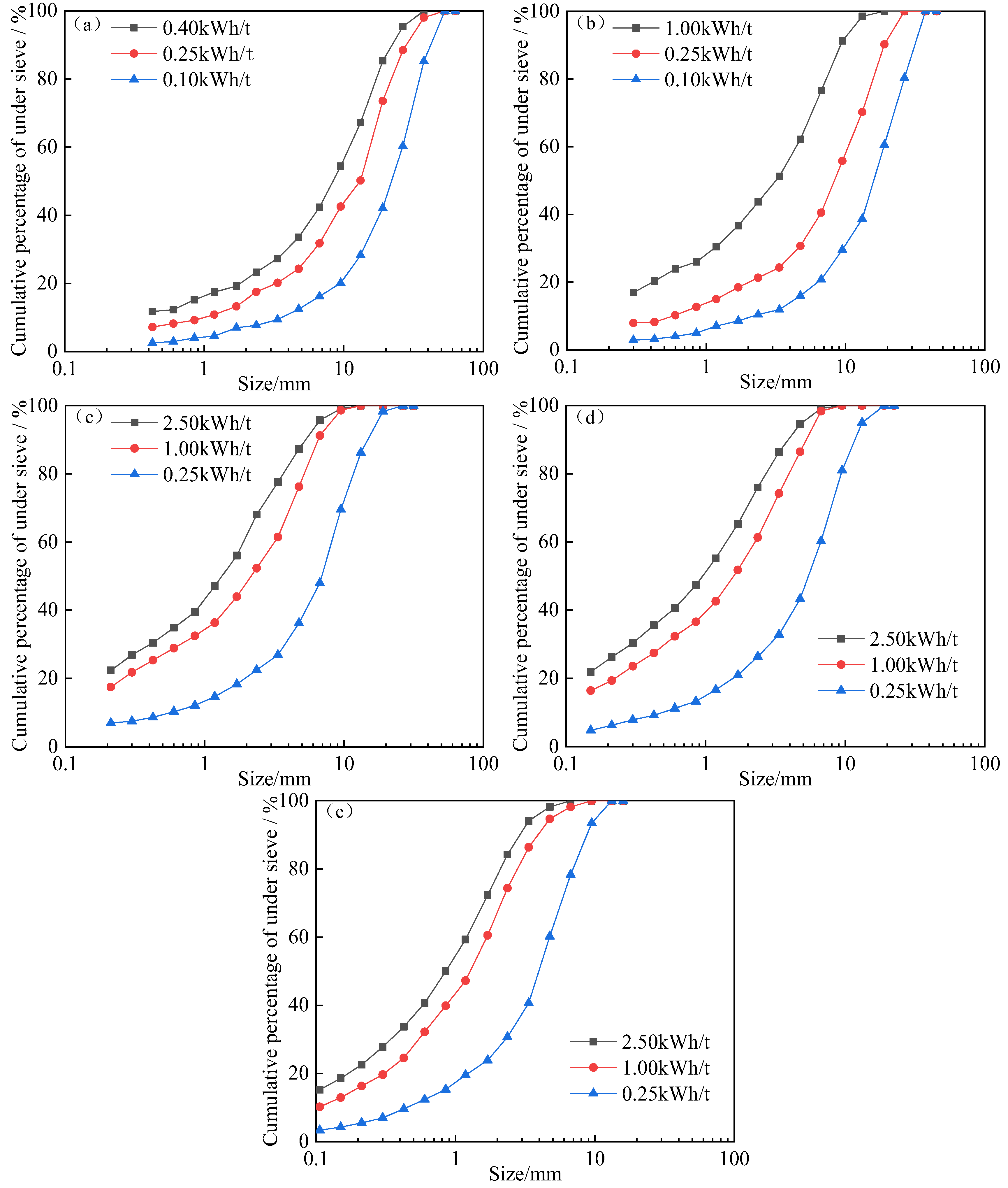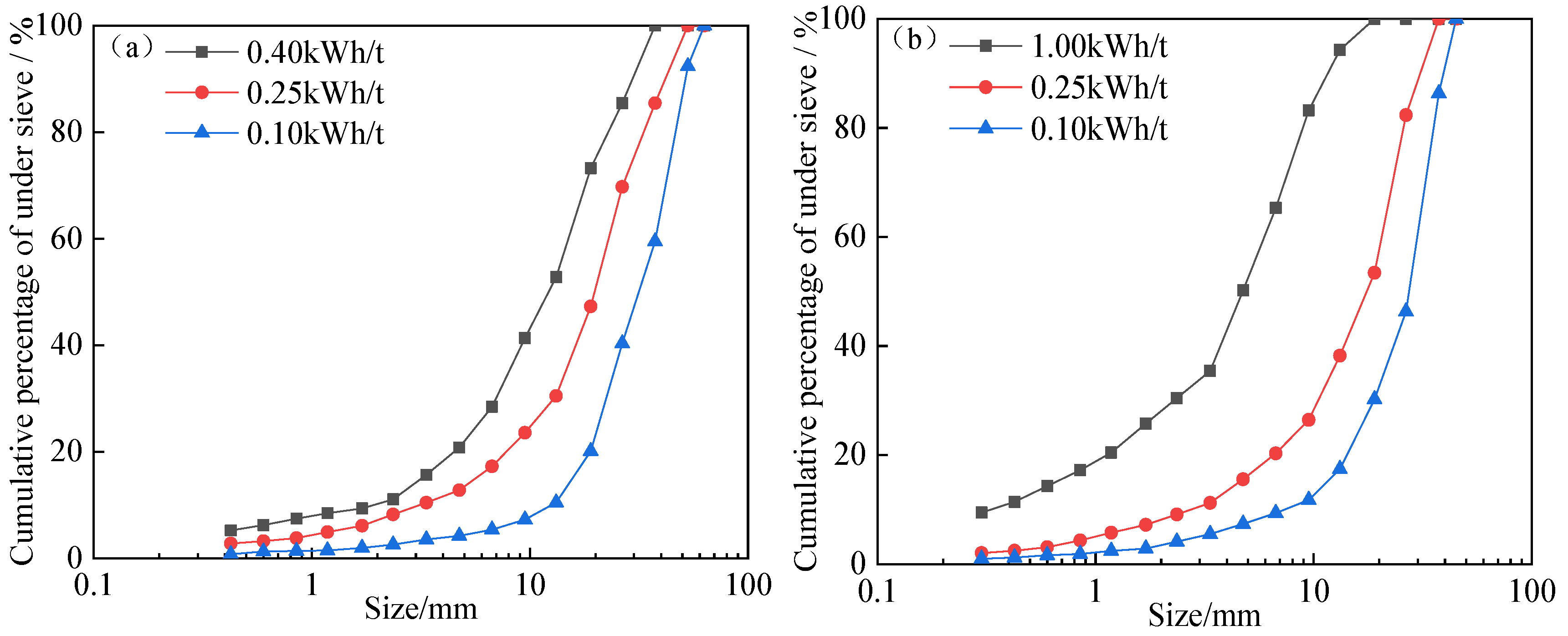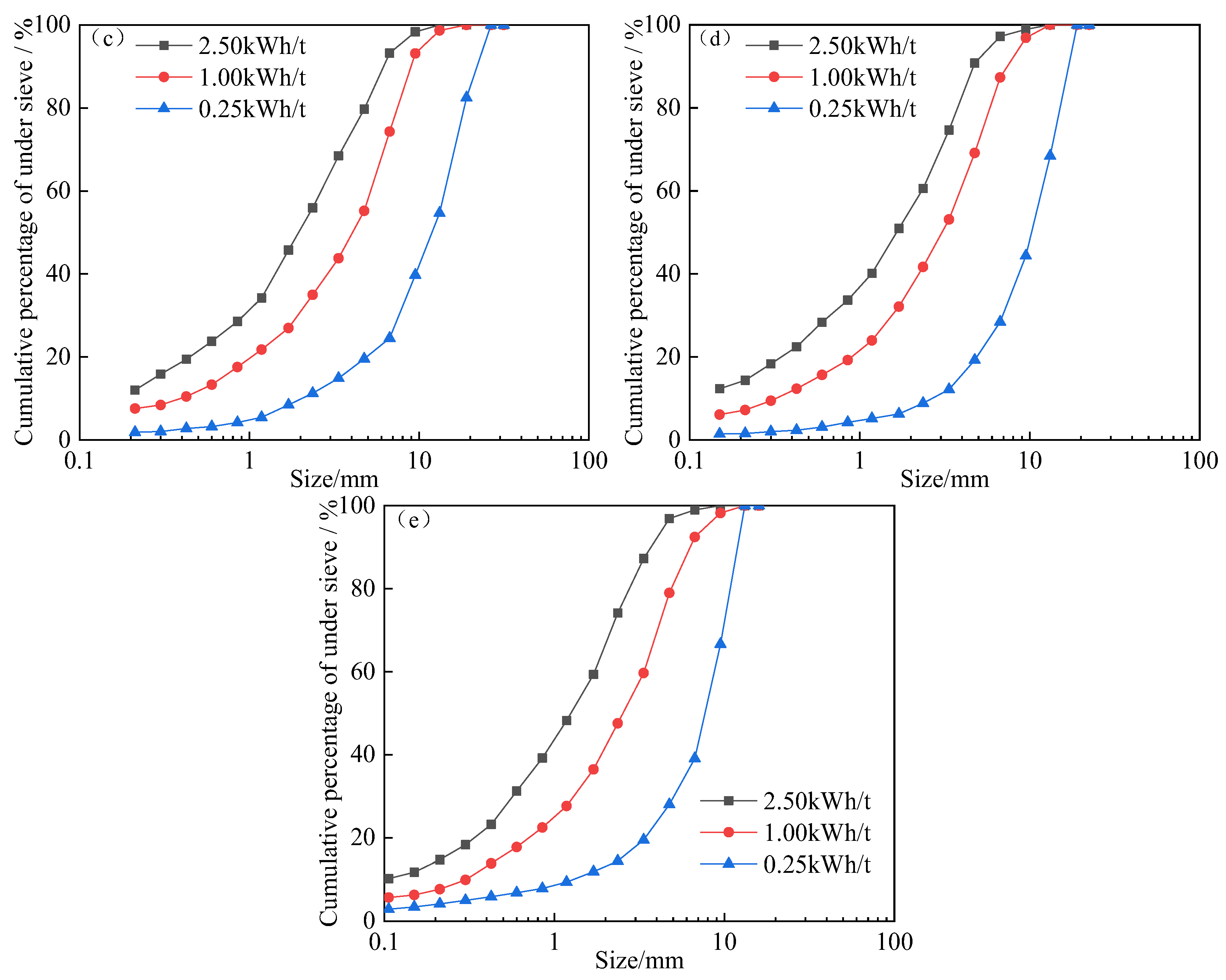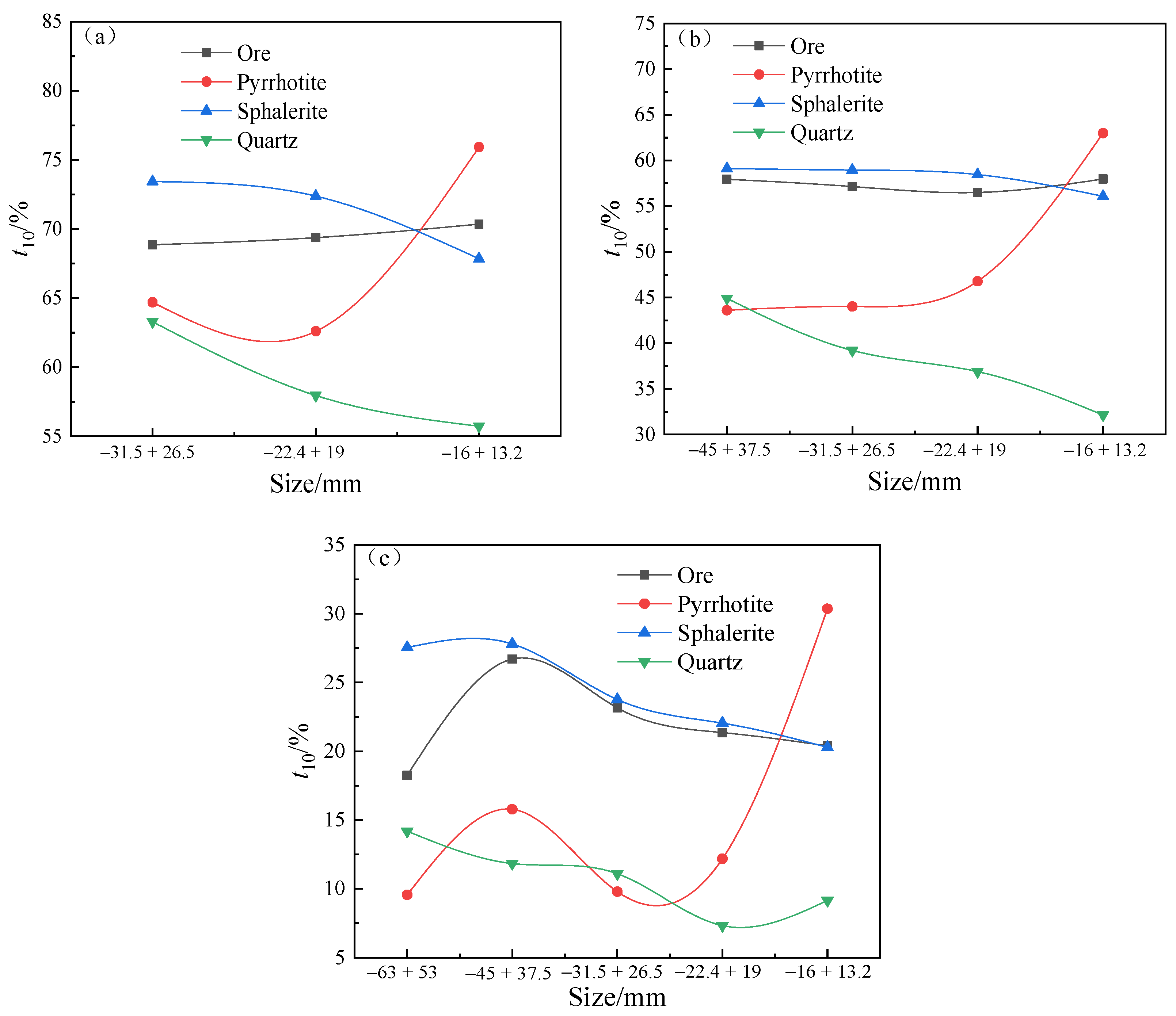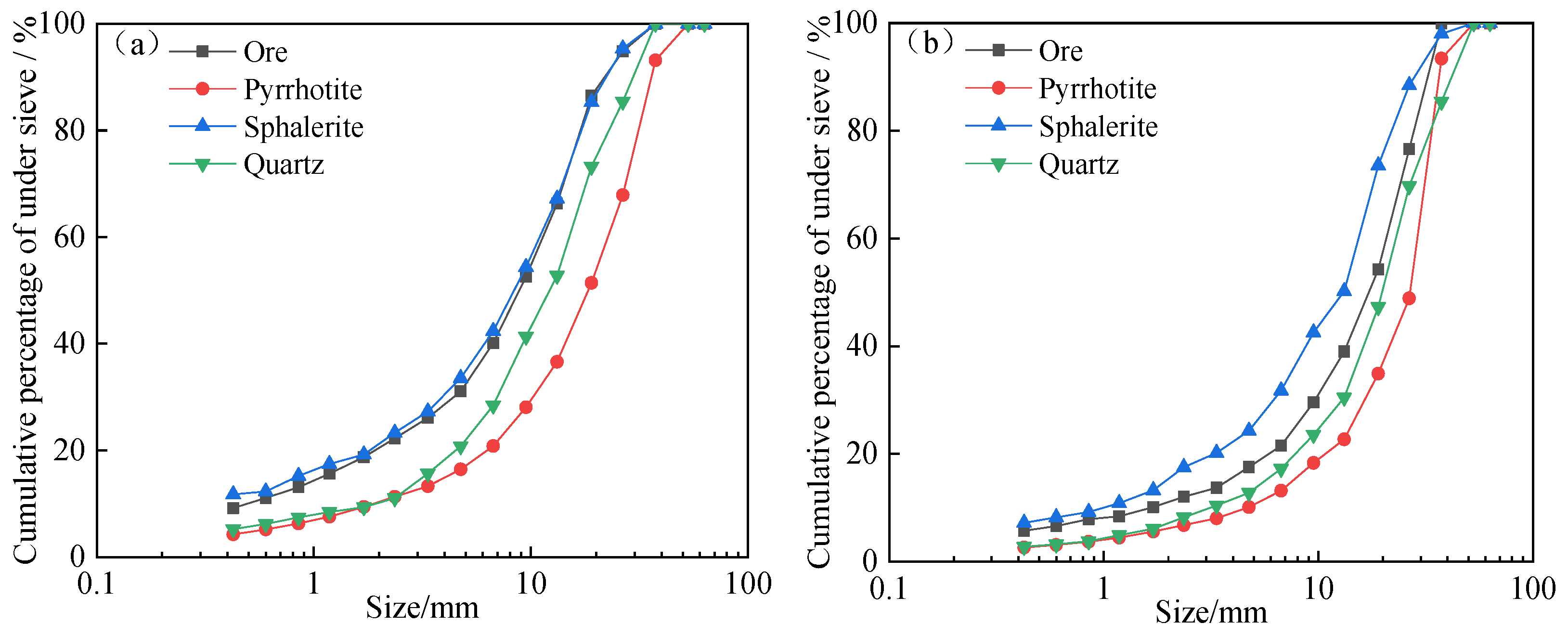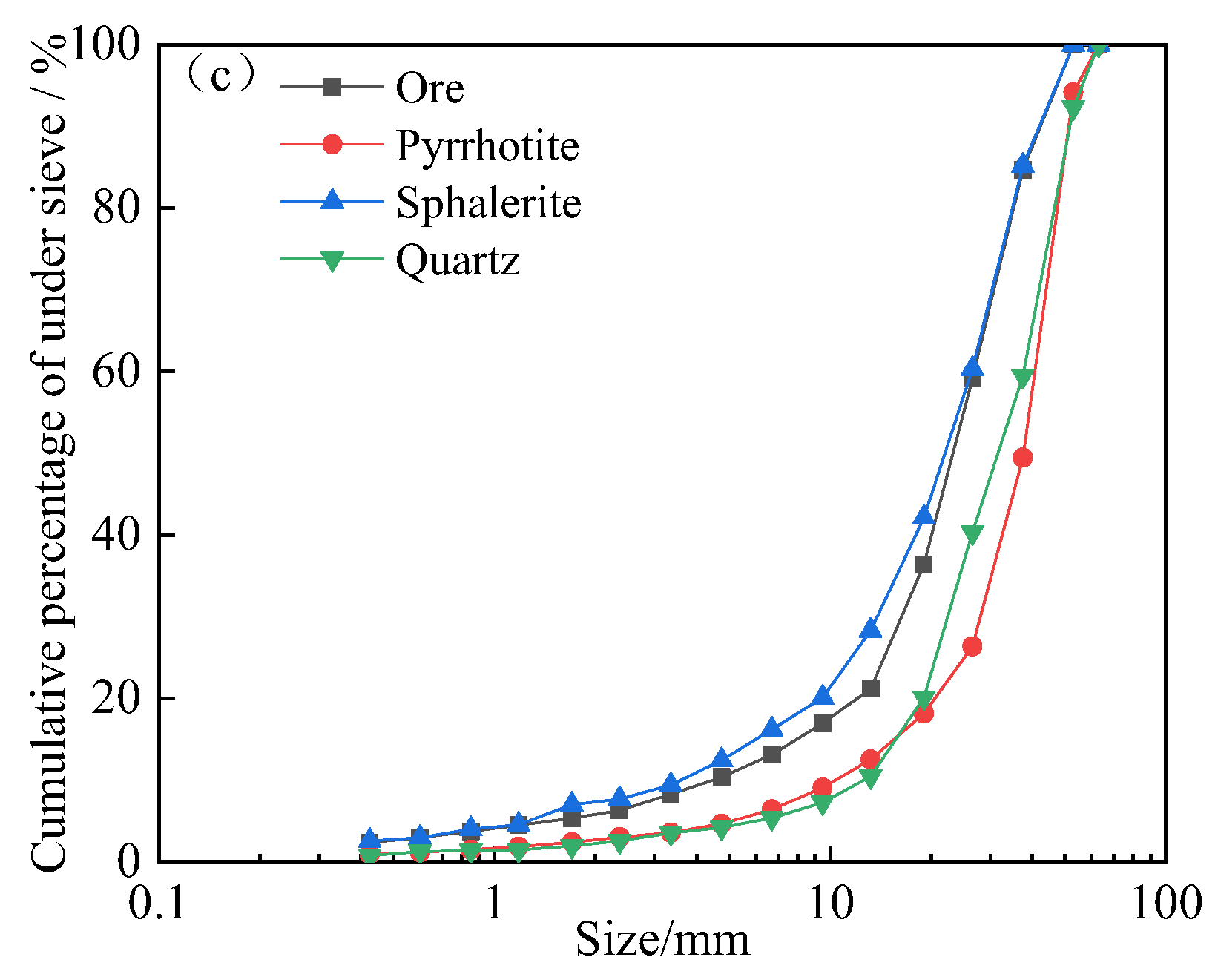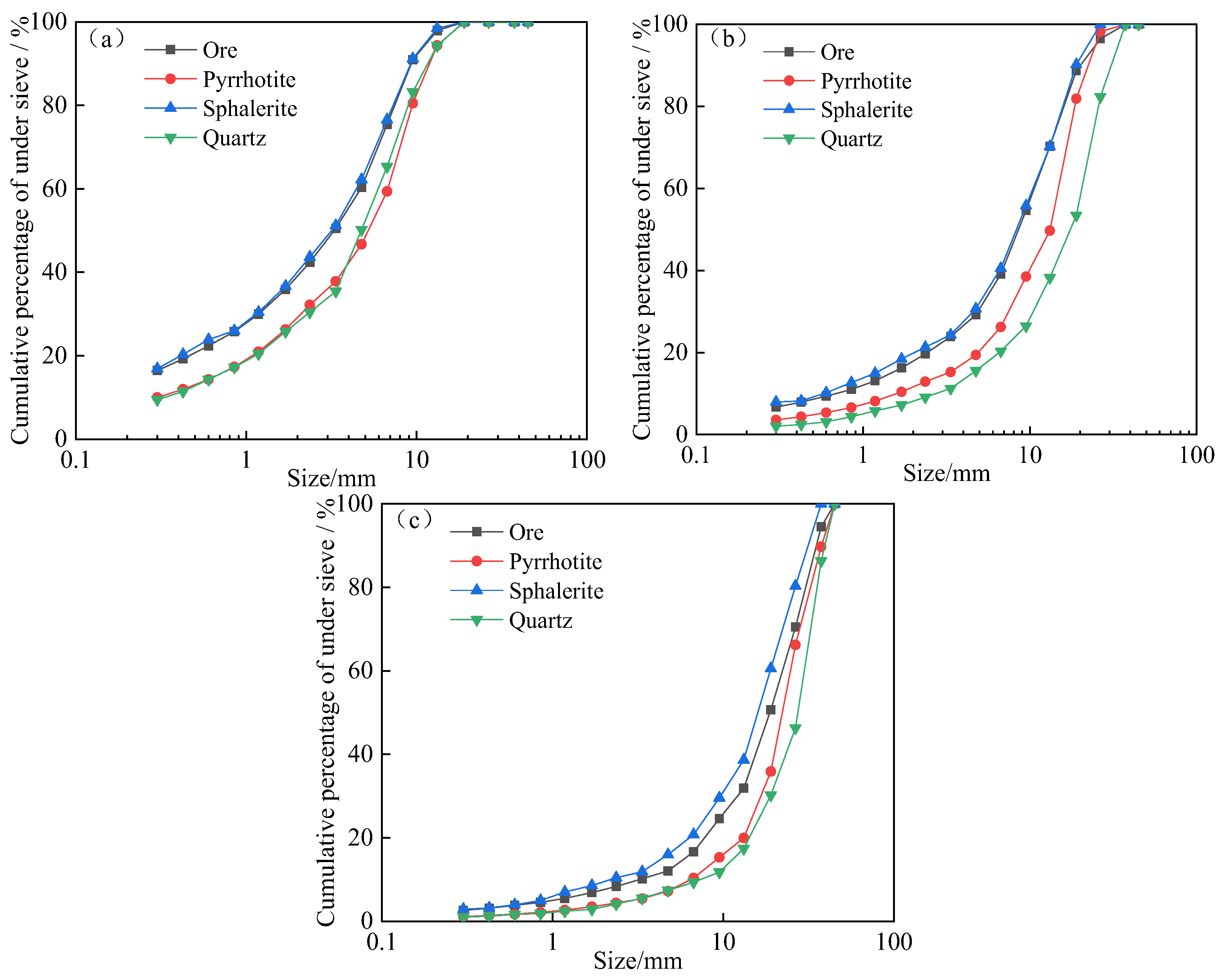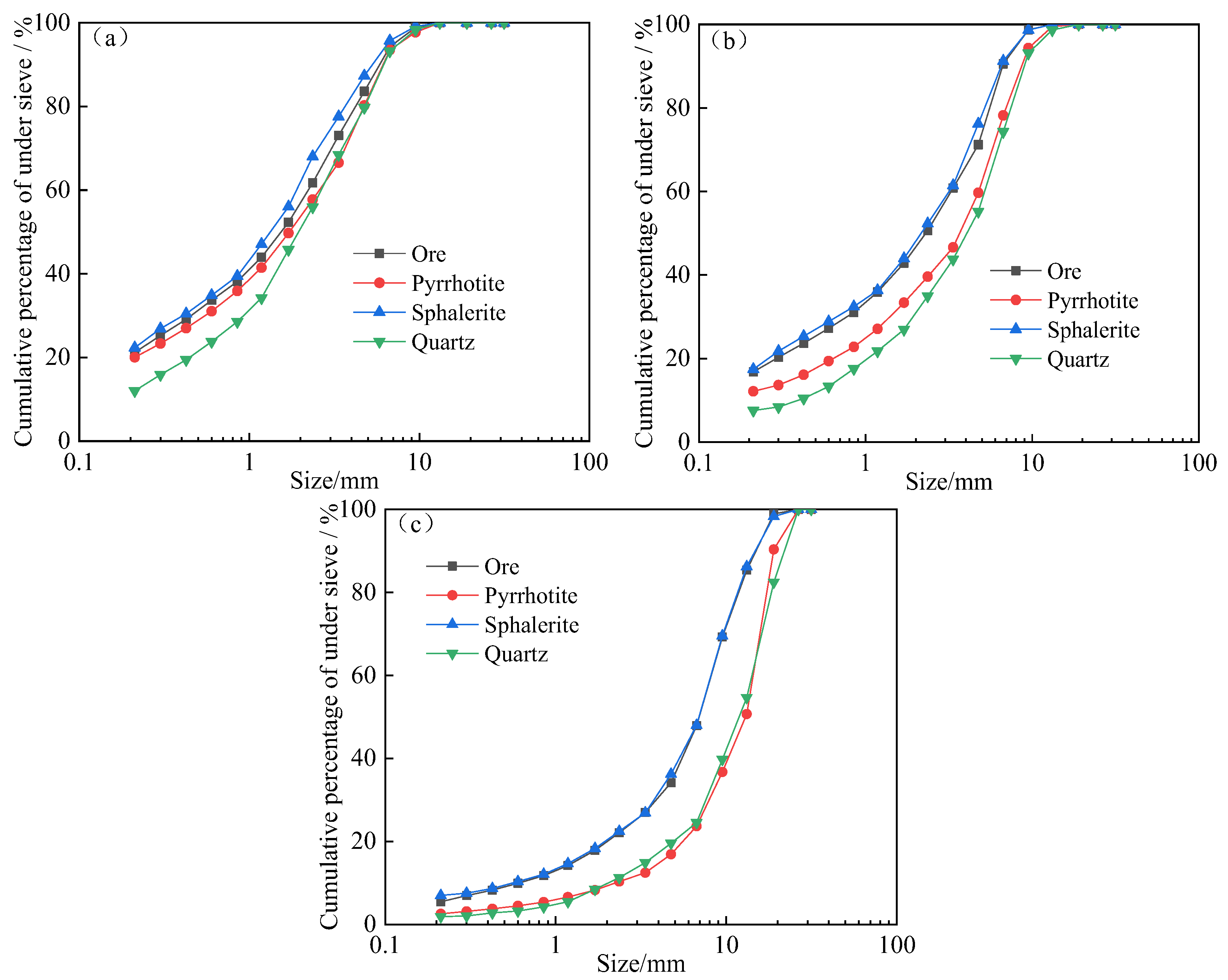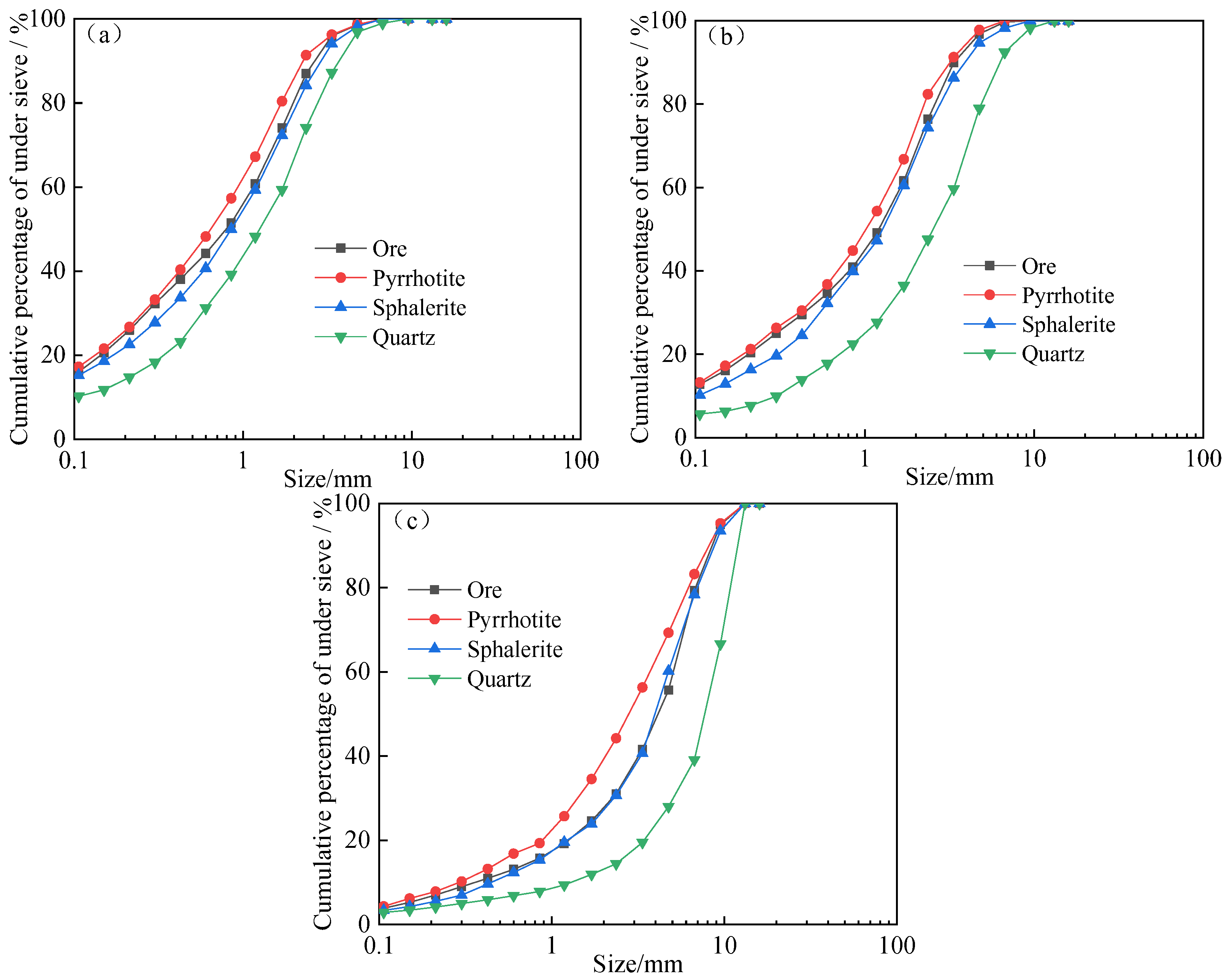3.1. Particle Size Distribution of Crushing Products
The products of the impact crushing tests of the multicomponent complex ore and its three component minerals, pyrrhotite, sphalerite, and quartz, which were performed under different
ECS, were screened and analyzed. Origin was used to create the cumulative yield curve of the products under sieve of ore and its component minerals in semi-log coordinates.
Figure 2 shows the cumulative yield curve of the impact crushing products of the ore.
Figure 3,
Figure 4 and
Figure 5 show the cumulative yield curves of the impact crushing products of pyrrhotite, sphalerite, and quartz.
Based on the analysis of
Figure 2,
Figure 3,
Figure 4 and
Figure 5, when the ore and its component minerals are subjected to impact crushing under the same feed particle size but different
ECS, the particle-size-distribution characteristic curve of the products is basically the same and approximately decreases exponentially. Because the
ECS increased, the particle-size-distribution curve of the ore and its component minerals gradually shifted upward. When the
ECS was closer, the particle-size-distribution curves of the impact crushing products tended to be closer. The reason was that under a certain sieving particle size, the greater the impact crushing energy acting on the ore and its component minerals, the more completely the ore and its component minerals are broken, and the greater the cumulative yield of its products under the sieve. Furthermore, when the
ECS is closer, the impact crushing effect tends to be closer. Moreover, the particle-size-distribution characteristic curves of the three impact crushing products of each particle size demonstrate that the two sides are close to each other and the middle distance was far, which indicates that the proportion of intermediate particle size produced by the ore and its component minerals under the instantaneous impact crushing force was larger than that of fine and coarse particle size. This phenomenon is consistent with the principle of crushing. The comprehensive analysis demonstrates that the impact crushing characteristics of ore and its component minerals are similar under the same feed size and the same
ECS. Generally, owing to the differences in physical, chemical, and mechanical properties of the different materials, during the process of impact crushing under the same conditions, different product particle size distributions will be generated, i.e., different impact crushing characteristics will be observed. This is attributed to the similarity and relationship between component minerals and complex ores. In other words, from the whole ore level to the main mineral level of the ore, there is a certain theoretical basis to examine the relationship between the impact and crushing characteristics of multicomponent complex ores under this condition. This is also the focus of this paper’s research. In subsequent sections, according to
Section 2.2, the data of the JK Drop Weight test in this section will be further processed to further explore the influence of component minerals on ore crushing.
3.2. Impact Crushing Characteristics of Ore and Its Component Minerals
Using the JK Drop Weight test data of the ore and its component minerals in
Section 3.1, the particle size distribution of the impact crushing products of the ore was analyzed according to Equation (2), and 15 groups of crushing products
t10 of each ore and its component minerals were calculated. Then, the actual
ECS of each group of the ore and its component minerals was combined with the desired crushing product
t10. Note that the
ECS–
t10 functional relationship was established using regression analysis of Equation (1), and then, the impact crushing characteristic parameters
A and
b of the ore and its component minerals were determined. The fitting curve is shown in
Figure 6, and the fitting results are shown in
Table 2.
Based on the analysis of
Figure 6 and
Table 2, with the increase in the
ECS, the crushing products
t10 of the ore and its component minerals increased. The greater the impact crushing energy acted on the ore sample, the more completely the ore sample was broken. The order of the
A ×
b value of the impact crushing characteristic parameters of the ore and its component minerals is quartz < pyrrhotite < ore < sphalerite. Thus, the order of impact crushing resistance of the ore and its component minerals is sphalerite < ore < pyrrhotite < quartz. The Mohs hardness of sphalerite is 3.5, that of pyrrhotite is 3.5–4.5, and that of quartz is 7. It indicates that the
A ×
b value and Mohs hardness have good compatibility.
Based on the analysis of
Figure 6 and
Table 2, the order of the fitting curve of the
ECS–
t10 relationship between the ore and its component minerals agreed with the order of the impact crushing resistance between the two. Under the same
ECS, the fitting curve of the
ECS–
t10 relationship of minerals with weak resistance to impact crushing is always higher than that of minerals with strong resistance to impact crushing. Moreover, the
ECS–
t10 relation fitting curve of the ore was always between the
ECS–
t10 relation fitting curve of component minerals with strong impact crushing resistance and weak impact crushing resistance. Comprehensive analysis shows that the ore was a mixture of its component minerals; therefore, the impact crushing characteristics of the component minerals would directly affect the impact crushing characteristics of the ore. Additionally, from the principle of fragmentation, it can also be judged that the crushing effect of the ore will be between its component minerals. In the comparative study, the impact crushing parameter
A ×
b value was used to characterize the impact crushing characteristics of the ore samples, i.e., the impact crushing resistance of ore samples. Therefore, the strength of the impact crushing resistance of the component minerals would directly affect the impact crushing strength of the ore. This corresponds to the analysis result of
Section 3.1, which confirms the rationality of extending the study of the ore to the study of the main component minerals. To analyze and compare the impact crushing characteristics of the ore and its component minerals, Origin was used to create a
t10 relationship diagram of crushing products under different feed sizes. The result is shown in
Figure 7.
As per the analysis of
Figure 7, the
t10 fitting curves of the ore crushing products of any feed size were between the
t10 fitting curves of its component-mineral crushing products under the same
ECS. This agreed with the results of the fitting curve of the impact crushing characteristic parameter
A ×
b and the
ECS–
t10 relationship. Under different
ECS, the changes in the crushing products
t10 of ore and its component minerals were complex, and no obvious rule could be identified. However, an extremely important experimental phenomenon was reported in the research process. That is, under different
ECS, when the ranges of feed sizes were from −22.4 + 19 to −16 + 13.2 mm, the position of the
t10 curve of the crushed product of pyrrhotite and sphalerite is reversed compared to that of the crushed product of the ore, and the
t10 curve of the crushed product of ore is still between the curves of the three component minerals. The reason for this phenomenon may be the presence of some impurities in the mineral. When the particle size of the mineral decreases, the small impurities in the mineral will have varying degrees of impact on the anti-crushing performance of the mineral. It is also possible that there are some small cracks in the mineral, and when the particle size of the mineral decreases, these cracks will, to some extent, promote the process of fragmentation, thereby affecting the regularity of fragmentation. After a comprehensive analysis of the test results, a reasonable conclusion was obtained, i.e., the impact crushing characteristics of component minerals affect the ore crushing characteristics, and there was a certain relationship between them that could be expressed using a mathematical model.
3.3. Influence of Component Minerals on the Impact Crushing Characteristics of Ore
Using the principle of selective crushing and from the perspective of material properties, the criterion for determining the influence of component minerals on their parent ore was formulated [
15,
16,
17]. Using the particle-size-distribution characteristic curve of the impact crushing products of the multicomponent complex ore, the impact crushing characteristics of the ore and its component minerals were compared and analyzed. Our results demonstrated that if the particle-size-distribution characteristic curve of the impact crushing products of component minerals is below the curve of the ore, this indicates that the cumulative yield under sieve of the products generated by the mineral crushing of this group is lesser than that of the ore, i.e., the resistance of the component to impact crushing is stronger than that of the ore. In this manner, it can be simply considered that the presence of the component minerals reduces the impact crushing effect of ore, and it can be considered that the existence of component minerals has a negative effect on the impact crushing effect of ore. However, it can be simply taken to indicate that the existence of component minerals improves the impact crushing resistance of the ore; in other words, the presence of component minerals has a positive impact on improving the impact crushing resistance of the ore. Based on the abovementioned theoretical analysis, the relationship between component minerals and the impact crushing characteristics of ore is qualitatively analyzed.
Figure 8,
Figure 9,
Figure 10,
Figure 11 and
Figure 12 show the relationship between the particle-size-distribution characteristic curves of component minerals and impact crushing products of ore.
From the analysis of
Figure 8,
Figure 9,
Figure 10,
Figure 11 and
Figure 12, under the same feed particle size, as the
ECS increases, the particle-size-distribution characteristic curves of the impact crushing products of the ore and its component minerals were somewhat similar. In the same range of feed particle size, the particle-size-distribution characteristic curve of the crushing products of ore was always “sandwiched” between the particle-size-distribution characteristic curve of the pyrrhotite, sphalerite, and quartz crushing products. When the feed particle size is −63 + 53, −45 + 37.5, −31.5 + 26.5, and −22.4 + 19 mm, the particle-size-distribution characteristic curve of the pyrrhotite crushing product is always under that of the ore crushing product. Moreover, the particle-size-distribution characteristic curve of the sphalerite crushing product is always above the grain-size-distribution characteristic curve of the ore crushing product. Based on the previous theoretical analysis, in the process of ore impact crushing, the presence of the component mineral pyrrhotite reduced the impact crushing effect of the ore; therefore, the presence of pyrrhotite in the ore has a negative effect on the impact crushing effect of the ore. The presence of sphalerite improves the impact crushing effect of ore, and the presence of sphalerite has a positive effect on the impact crushing effect of ore. When the feed particle size was in the range of −16 + 13.2 mm, the “position” of the particle-size-distribution curve of the crushed products of pyrrhotite and sphalerite was reversed compared to that of the ore. The particle-size-distribution characteristic curve of the crushing products of pyrrhotite was above that of the ore, while the particle-size-distribution characteristic curve of the crushing products of sphalerite was below that of the ore. This indicates that the impact crushing properties of the component pyrrhotite and sphalerite minerals should have changed compared to the ore when the feed size was −16 + 13.2 mm, and the original negative effect of pyrrhotite on the impact crushing effect of ore should have transformed into a positive effect. However, the active effect of sphalerite on the impact crushing effect of ore changed to a negative effect. Quartz was always under the particle-size-distribution characteristic curve of the ore crushing products in the feed-size ranges of −63 + 53, −45 + 37.5, −31.5 + 26.5, −22.4 + 19, and −16 + 13.2 mm, which indicates that the existence of quartz always reduced the impact crushing effect of the ore. That is, it always has a negative effect on the impact crushing effect of the ore. There is currently no very clear conclusion on the reasons for the above phenomenon. It may be that the anti-crushing performance of ores with different particle sizes is different. The particle-size crushing effect of different ores is different, which may also lead to the reversal of the crushing effect of pyrrhotite and sphalerite on ores at –16 mm. It may also be that the purity of magnetite pyrite and sphalerite is not enough, and there are some small impurities in the minerals. When the particle size of minerals becomes smaller, the fine impurity ores will have different degrees of impact on the anti-crushing properties of magnetite pyrite and sphalerite. It is also possible that there are some small cracks in the mineral, and when the particle size of the mineral decreases, these cracks will, to some extent, promote the process of fragmentation, thereby affecting the regularity of fragmentation. In response to this phenomenon, we will conduct in-depth research and analysis in the future, striving to quantitatively express its principles and laws.
